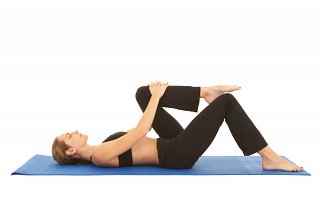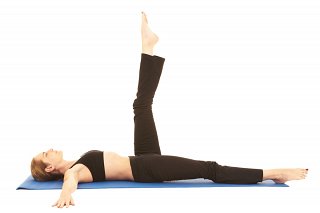Back Pain Exercises

I sometimes get readers and patients contacting me who are in the middle of an episode of back pain, and are looking for exercises or stretches to help alleviate their pain. They have been googleing various stretches and exercises for back pain and also seek my opinion on this.
Back Pain Exercises or stretches can be quite hard to recommend, and my advice is always to go and see your local physio or medical doctor before you start. In this article, I look at the things to consider about what exercises you should do when you have back pain and introduce some sample exercises that we would generally use with our patients.
Sponsored links
Back pain - exercise and stretching

As mentioned above, try to keep pain free moving where you can in the initial stages of a back pain episode and if you are unsure of the underlying cause of your back pain, visit professional advice of a doctor or chartered physiotherapist to get a proper diagnosis first. With the help of your chartered physiotherapist, the appropriate exercises for your condition can be advised and started at the correct time.
A frequent mistake people make is to start strength, fitness or stretching exercises too early, and even exercise into pain. Don’t do it! Avoid strengthening exercises until your back pain has gone, or until your chartered physiotherapist or doctor has given you the all clear to engage with strength exercises. When you have recovered from your back pain, begin the core conditioning programme to target your core muscles and thus reduce the chance of recurring back pain. Range of movement and stretching exercises are best started ONLY once the back pain has resolved.
Having said that, it is generally ok to start gentle stretches so long as you do not have pain when doing so. Stretching exercises for the back increases circulation to the muscles and ligaments in the area - all the time enhancing healing.
Gently stretching can also relieve tight muscles and back pain and help increase mobility. Prior to starting your stretching exercises, warm up with a hot shower which will increase the [circulation] http://www.netdoctor.co.uk/ask-the-expert/heart-and-blood/ “Net Doctor article that introduces circulation”) and loosen the muscles before you start. Heat (like a hot water bottle or heat pack) also eases your back pain which will help you to do the exercises more comfortably.
Sample Back Stretches
Warm up exercises.
I always advise people to warm up before any form of exercise. Ten minutes of walking, exercise bike or even walking on the spot is adequate. The importance of this general warm up is to increase the circulation to the muscles so that can perform in both stretching and strengthening movements. This will reduce the likelihood of injury while performing these exercises.
a. Lower back stretch 1:
This stretch helps strengthen your core muscles and is great for helping lower back pain.
- Lie on your back, knees bent, feet flat on the floor.
- Flatten the small of your back against the floor, tightening your buttocks and tummy muscles.
- Hold for the count of five.
- Slowly release.
- Repeat ten times.
b. Lower back stretch 2:
- Lie on your back, knees bent, feet flat on the floor.
- Extend your arms out to the side.
- Have your feet and knees hip distance apart.
- Inhale deeply.
- As you exhale, slowly lower both your knees towards the right side, as close to the floor as you can comfortably go.
- Inhale and exhale slowly five times in this position.
- As you exhale, slowly bring your knees back to the start position.
- Repeat five times towards each side.

c. Gluteal Stretch:
- Lie on your back, knees bent, feet flat on the floor hip distance apart.
- Place your hands behind your right knee and gently pull your left knee towards your right shoulder as far as is comfortable.
- Hold for the count of 10 then gently return knee to start position.
- Repeat five times on each side.

d. Leg Stretch
- Lie flat on your back, legs extended onto the floor.
- Carefully raise the right leg up and place your hands behind the right knee.
- Extend your big toe towards the ceiling.
- Imagine your right hip sinking into the floor and your big toe lengthening towards the ceiling.
- Aim to have the knee as straight as possible.
- Hold for 20 seconds.
- Gently and carefully return leg to the original position.
- Repeat 5 times on each side.

e. Back Stretch 3:
- On all fours, hands under shoulders, knees under hips.
- Inhale.
- As you exhale, move your bottom back towards and sit on your your heels, keeping your hands in a stationary position in front of you.
- Allow your head to drop towards your thighs.
- Hold this position for 30 seconds.
- Gently come back out onto all fours and repeat this process five times.

f. Cobra:
- Lie flat on your stomach, forehead on the ground and arms bent with palms down under shoulders.
- Push through your hands and extend your upper body upwards as far as is comfortable
- Your torso will raise, your back will arch.
- Inhale 5 times.
- Exhale 5 times and then slowly return your torso to the ground.
- Repeat 5 times.

Sponsored links
These are some of the stretches that we would do as part of a back pain management program. Once the back pain has resolved, we would look to strengthen the back muscle. Strengthening of your back is a slow process - and I have found that these Back Strengthening Exercises and Pilates exercises to be very effective in regaining strong muscles in your back.
You can find more Lower Back Stretches here.
DISCLAIMER
While the content and materials contained in the articles on this website have been written & researched by Sally Ann Quirke, a professional, practising & fully qualified Chartered Physiotherapist (Physical Therapist) based in Ireland, they are provided for general information and educational purposes only. They do not constitute medical advice on any particular individual situation. Please see your Chartered Physiotherapist or other medical practitioner for full and individual consultation.
Please read the full disclaimer here.
Cookies and Privacy
By using this website, you consent to the use of cookies in accordance with our cookie policy. For more information on how we use cookies, please read our cookie policy here.
